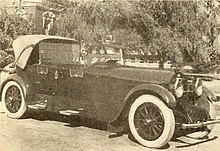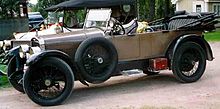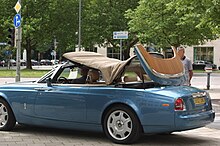Phaeton (body design)

The Phaeton has been a widely used body design since the invention of the automobile . The name "Phaeton", which comes from a figure from the Greek world of legends (→ Phaethon ), went from the carriage to the first automobiles or "motorized carriages ". Gottlieb Daimler's first motor car in 1886 was a motorized Phaeton Americaine, which was supplied by the Stuttgart carriage builder Wimpff & Sohn . Automobiles with Phaeton bodies were available as open two or four-seaters from almost all manufacturers. The automobile boom in Phaeton design reached its peak around 1910.
Two-seater
Open vehicles from 1900 to around 1920 that offered space for two people in a row of seats were called Phaeton or two-seater . The windscreen, doors and convertible top were added over time or were available for an extra charge. In the Automobil-Welt of May 1907 open two-seaters are depicted and designated as follows: Adler 4/8 PS and Rex-Simplex as two-seater, Laurin & Klement B as two-seater, Cito Citomobil , Ley Loreley and Victoria two-seater as Phaeton. On vehicles with a front engine there is a clearly visible bulkhead behind the engine . The two-seater Phaeton was replaced from around 1910 by the two-seater torpedo , which, unlike the Phaeton, had a continuous side body.
After 1918 the term torpedo went out of fashion. Side windows and the term roadster slowly took hold .
Without windscreen, doors and hood:
Brouhot from 1906With hood:
Laurin & Klement AWith windscreen, doors and hood:
Spyker 7 HP from 1912Already a torpedo :
Bugatti Type 19 from 1911
Four seater
Open vehicles up to around 1920, which offered space for four people in two rows of seats, were called double phaeton or, in many cases, simply phaeton or four-seater . The prerequisite was that all seats were facing forward. Vis-à-vis , dos-à-dos and tonneau are therefore not included. The windscreen, doors and hood were added over the years or were available for an extra charge. The rear doors were more likely to prevail than the front ones. In the Automobile World of May 1907, an open four-seater of the Apollo Piccolo type is shown and referred to as a double phaeton. In the Automobil-Welt of April 1907 two more open four-seater are shown and designated as follows: Stoewer P 6 as (double) Phaeton, Horch 50/60 HP as double Phaeton. On vehicles with a front engine there is a clearly visible bulkhead behind the engine. From around 1910 the four-seater Phaeton was replaced by the four-seater torpedo, which, in contrast to the Phaeton, offered a smooth transition from the bonnet to the windshield and a continuous side body.
After 1918 the vehicles were called Phaeton or touring cars again . They still had no side windows (sometimes blanking windows) and thus offered less weather protection than a convertible . Demand fell until World War II . The Kübelwagen was the last variant of the Phaeton .
Without windscreen, doors and hood:
Koch from 1898Without windshield, but with rear doors and hood:
NAG from 1908With windscreen, rear doors and hood:
Spyker 15/22 HP from 1907With windscreen, continuous body and hood:
Ford Model T
Special forms
Triple Phaeton
Open vehicles with three rows of seats were called Triple-Phaeton until around 1920 .
skiff

The skiff is a spectacular hybrid of different open body shapes, for example from touring or. Phaeton, Torpedo and, more rarely, Roadster . The structure is made entirely of wood and is made using boat building methods. The stern usually ends in the shape of a boat. Doors and interior panels are often missing. The skiff was a predominantly French fad. The costs of building and maintaining the bodies and their lack of suitability for everyday use prevented their spread. Skiff are often associated with the coachbuilder Jean-Henri Labourdette , who built the first skiff on the chassis of a Panhard & Levassor in 1912 .
Scaphander
The scaphander is an almost forgotten French invention. As with the Dual Cowl Phaeton, there are two passenger compartments. The front is reserved for the chauffeur, the rear is tiny and pushed right to the end of the vehicle. There are versions with a fixed roof or open, which can be closed weatherproof with a hood and windows. To get in, part of the front cover including the windshield is folded forward before the doors can be opened.
The name is derived from Scaphander , an old term for a helmet diving device , because the rear cabin is reminiscent of a diving helmet . This remarkably impractical body design found few buyers. Such superstructures on chassis from Hispano-Suiza , Renault 40 CV and Panhard & Levassor are known ; the latter introduced in 1924 one of Jean-Henri Labourdette karossierten and as Skiff Cab designated Scaphandrier out with wooden body (see. Skiff) at the Paris Motor Show.
Salon Phaeton
The term salon only refers to the arrangement of the seats and is not limited to the Phaeton; it is also the touring car , the sedan and the sedan known and has been used by luxury brands like. The salon arrangement roughly corresponds to that of modern minivans , but with firmly attached seats and benches. Two more seats are attached behind the front individual seats so that there is a gap between them. It appears that later jump seats were used that could be folded up and sunk into the ground. These seats are normally accessible through the rear doors. The gap between the seats is the passage to a bench in the stern.
Closed-coupled Phaeton

The rear compartment has been moved forward at the expense of legroom, creating space in the rear for an integrated trunk, which is usually located between the rear fenders. Some coachbuilders used made-to-measure suitcases that fit exactly into the designated hollows. The term close coupled was also applied to other body designs; a closed one is the Brougham .
Tourster, Foursome, Sport model

Tourster is a word made up of "Touring" and "Roadster". This sub-form of the Phaeton was less common and disappeared in the early 1930s. Exclusive manufacturers often offered a 5-seat Phaeton and a 4-seat Tourster in parallel. The body of the Tourster is slimmer than that of the normal Touring resp. Phaeton and usually shorter. The tourster is typically 4-seater and 4-door. The term overlaps with the torpedo . The last and best-known toursters include the version built on the long Duesenberg chassis by Derham in the early 1930s . The Packard 734 Speedster Phaeton was by definition a tourster.
Dual Cowl Phaeton
Another variant of the Phaeton is the Dual Cowl Phaeton, sometimes also called the Double Cowl Phaeton. "Cowl" is the English name for the torpedo sheet between the hood and the passenger compartment. What is meant is that the front and rear passenger compartments are completely separated from one another. Often amenities such as a drinks bar or an extendable dressing table are built into the partition. As a rule, a foldable (seldom: retractable) second windshield is attached above this, which better protects the rear passengers from the airstream. With some Dual Cowl Phaeton, a cover including the window must be folded forward to get in and out. Probably the first Dual Cowl Phaeton was built in 1916 by J. Franklin deCausse (1879–1928) on a Locomobile Model 48 chassis for the warehouse king, John Wanamaker .
The term “Phaeton” in the DIN standards
According to the German standard DIN 70011 “Superstructures for passenger cars; Designations and terms ”from March 1959, the“ Phaeton (touring car) ”was defined as an open passenger car with two or more seats, two or four doors and detachable or detachable side panels; the top had to be designed as a retractable or retractable scissor top or as a retractable or removable folding top.
VW Phaeton
The Volkswagen Group chose the name VW Phaeton for its first luxury vehicle (sales began in 2002) .
literature
- Harald H. Linz, Halwart Schrader : The International Automobile Encyclopedia . United Soft Media Verlag, Munich 2008, ISBN 978-3-8032-9876-8 .
- Joachim Wachtel (editor): Facsimile cross section. Early automobile magazines. Scherz Verlag, Bern and Munich, 1985, pp. 104-105. (without ISBN)
- Beverly Rae Kimes (Editor), Henry Austin Clark Jr.: Standard Catalog of American Cars 1805–1942. 3. Edition. Krause Publications, Iola WI (1996), ISBN 978-0-87341-428-9 ISBN 0-87341-428-4 . (English)
Web links
- coachbuilt.com: J. Franklin deCausse (accessed September 3, 2014)
- conceptcarz.com: Peugeot Type 150 (1913) and description of the Skiff (English) (accessed September 3, 2014)
- conceptcarz.com: Panhard & Levassor Type Q double phaeton by Labourdette (accessed September 3, 2014)
- coachbuild.com: Labourdette Panhard 40 / 50hp Skiff-Cab (accessed September 3, 2014)
Individual evidence
- ↑ a b c Wachtel: Facsimile cross section. Early automobile magazines.
- ↑ a b Harald H. Linz, Halwart Schrader : The International Automobile Encyclopedia . United Soft Media Verlag, Munich 2008, ISBN 978-3-8032-9876-8 .
- ↑ conceptcarz.com:> Peugeot Type 150 (1913) and description of the Skiff
- ↑ coachbuild.com: Labourdette Panhard 40 / 50hp Skiff-Cab
- ↑ packardinfo.com: Packard Dominant Six 3-48 Two-toned Salon Brougham (1914)
- ^ Butler: Auburn Cord Duesenberg. 1992, p. 107.
- ^ Butler: Auburn Cord Duesenberg. 1992, p. 304.
- ↑ coachbuilt.com: J. Franklin deCausse
- ↑ Kimes, Clark: Standard Catalog of American Cars 1805-1942. 1996, p. 890












